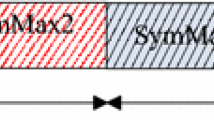Abstract
V2V channel models with moving scatterers produce a Doppler effect up to 12 times that of channel modeling that fits the movement of a single vehicle. As a result, the estimation of the channel always needs to be updated quickly, and the duration of the data symbol on frame 802.11p will be limited. Furthermore, there is no data symbol that can be carried in the Coherence Time (CT) range, which causes estimation errors. To overcome this, a method is needed to detect the value of CT from the channel. We improved the CT detection method on the V2V channel from our previous study with a correlation coefficient > 0.5 so that according to the reference theory. Furthermore, the CT detection results are used as the limit of long training symbol (LTS) duration and the symbol data in one frame to be sent. The duration of data symbols and LTS were set to always be within the CT range, and after the CT duration ended, the next LTS was sent to detect the next channel response and the new CT. The CT detection results that we performed resulted in an average difference in CT detection results with the CT theory of 0.0023 ms. The performance of the proposed method was up to 63% that of the spectral temporal average (STA) method and the known coherence time (KCT) method for the scenario where the data symbol length was still in the CT period. This makes the proposed approach very practical for use according to standardization 802.11p in the vehicular ad hoc network (VANET) communications system.












Similar content being viewed by others
References
A. Chachich, V. Fessmann, J. Arnold, D. Thompson, W. Fehr, and S. Stasko, DSRC-Unlicensed Device Test plan To characterize the existing radio frequency signal environment, Washington DC, 2015.
J. Fernandez, D. Stancil, and F. Bai, Dynamic Channel Equalization for IEEE 802.11p Waveforms in the Vehicle-To-Vehicle Channel, IEEE 2010 48th Annual Allerton Conference on Communication, Control, and Computing (Allerton), 2010, pp. 542–551. https://doi.org/10.1109/ALLERTON.2010.5706954.
A. Borhani and M. Ptzold, Modeling of vehicle-to-vehicle channels in the presence of moving scatterers, IEEE Vehicular Technology Conference, 2012. https://doi.org/10.1109/VTCFall.2012.6398895.
W. Pamungkas, T. Suryani, I. Wirawan, and A. Affandi, Doppler Effect Mitigation Using Spectral Temporal Average Estimation on V2V Channel with Moving Scatterer, IEEE International Conference on Cybernetics and Computational Intelligence (CyberneticsCom), 2019, pp. 114–119. https://doi.org/10.1109/CYBERNETICSCOM.2019.8875689.
J. A. Fernandez, et al., Performance of the 802.11p Physical Layer in Vehicle-to-Vehicle Environments, IEEE Trans. Veh. Technol., Vol. 61, No. 1, pp. 3–14, 2012. https://doi.org/10.1109/TVT.2011.2164428.
Z. Zhao and C. Wang, Channel Estimation Schemes for IEEE 802.11p Standard, IEEE Intell. Transp. Syst. Mag., Vol. 5, pp. 38–50, 2013. https://doi.org/10.1109/MITS.2013.2270032.
H. Jiang, S. Cai, W. Xiang, and H. Qian, Dynamic Channel Estimation for Vehicle Wireless Communications, Lecture Notes of the Institute for Computer Sciences, Social-Informatics and Telecommunications Engineering, LNICST, 2013, vol. 121 LNICST, pp. 14–24. https://doi.org/10.1007/978-3-642-41773-3_2
W. Pamungkas, T. Suryani and A. Affandi. Wirawan, Coherence time and doppler spectrum of V2V channel with moving scatterer based on autocorrelation function, J. Commun., Vol. 14, pp. 859–865, 2019.
A. J. Goldsmith, Wireless Communications, no. 143, Cambridge University Press, Cambridge, 2005.
E. A. Feukeu, K. Djouani and A. Kurien, Doppler Shift Mitigation in a VANET using an IDDM approach, J. Ambient Intell. Humaniz. Comput., Vol. 7, No. 3, pp. 321–332, 2016. https://doi.org/10.1007/s12652-016-0365-4.
H. Zhao, S. Lu, R. Zou, K. Ju and K. H. Chon, Estimation of time-varying coherence function using time-varying transfer functions, Ann. Biomed. Eng., Vol. 33, No. 11, pp. 1582–1594, 2005. https://doi.org/10.1007/s10439-005-7045-4.
J. Dulmage, M. P. Fitz, and D. Čabrić, A modulation dependent channel coherence metric for VANET simulation using IEEE 802.11p, IEEE Veh. Technol. Conf., 2010. https://doi.org/10.1109/VETECS.2010.5494109.
X. Yin, J. Zhou, B. J. Kwak, and H. K. Chung, Estimation of channel temporal auto-correlation and coherence time based on propagation paths, 2010 5th International ICST Conference on Communications and Networking in China, ChinaCom 2010, 2010, pp. 1–5. https://doi.org/10.4108/chinacom.2010.11.
M. S. Kim, T. S. Lee, T. H. Im, and H. L. Ko, The analysis of coherence bandwidth and coherence time for underwater channel environments using experimental data in the West sea, Korea, Ocean. 2016—Shanghai, pp. 2–5, 2016. https://doi.org/10.1109/OCEANSAP.2016.7485600.
L. Cheng, B. Henty, F. Bai, and D. D. Stancil, Doppler spread and coherence time of rural and highway vehicle-to-vehicle channels at 5.9 GHz, GLOBECOM—IEEE Glob. Telecommun. Conf., no. May 2014, pp. 4180–4185, 2008. https://doi.org/10.1109/GLOCOM.2008.ECP.802.
U. Schilcher, J. F. Schmidt, M. K. Atiq, C. Bettstetter and I. T. Jun, Auto-Correlation and Coherence Time of Interference in Poisson Networks, IEEE Trans. Mob. Comput., Vol. 19, No. 7, pp. 1506–1518, 2020. https://doi.org/10.1109/TMC.2019.2912373.
W. Pamungkas, T. Suryani, W. Wirawan and A. Affandi, Power spectral density of V2V communication system in the presence of moving scatterers, Int. J. Intell. Eng. Syst., Vol. 12, No. 6, pp. 207–214, 2019. https://doi.org/10.22266/ijies2019.1231.20.
A. Borhani and M. Patzold, Correlation and spectral properties of vehicle-to-vehicle channels in the presence of moving scatterers, IEEE Trans. Veh. Technol., Vol. 62, No. 9, pp. 4228–4239, 2013. https://doi.org/10.1109/TVT.2013.2280674.
G. E.P Box, G. M. Jenkins, G. C. Reinsel, G. M. Ljung, (2016) Time Series Analysis Forecasting and Control. Wiley, New Jersey
Acknowledgements
The works presented in this paper are sponsored by the Ministry of Finance of the Republic of Indonesia through the LPDP Scholarship.
Author information
Authors and Affiliations
Corresponding author
Additional information
Publisher's Note
Springer Nature remains neutral with regard to jurisdictional claims in published maps and institutional affiliations.
Rights and permissions
About this article
Cite this article
Pamungkas, W., Suryani, T., Wirawan et al. Doppler Effect Mitigation on V2V Channels with Moving Scatterers Using Dynamic Equalization Based on the Coherence Time. Int J Wireless Inf Networks 28, 332–343 (2021). https://doi.org/10.1007/s10776-021-00513-y
Received:
Revised:
Accepted:
Published:
Issue Date:
DOI: https://doi.org/10.1007/s10776-021-00513-y




